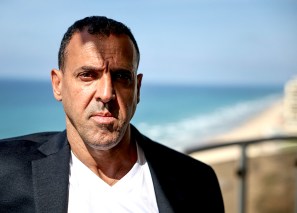‘Oh Daddy, please can I have that Nazi eagle badge.
‘Oh Daddy, please can I have that Nazi eagle badge. Oh please, oh please.’
We’re standing in the gift shop of the Baugnez ’44 memorial museum outside Malmedy, Belgium — me, Grandpa (aka my dad) and Girl — and we’re peering longingly into the original second world war memorabilia display case like Tiny Tims at Christmas. There are so many things we’d like if only we had the money: original GI helmets (€400 for a good one, with decent leather strap), packets of vintage Camels, tins of delousing powder, camouflage sticks, Wehrmacht pay books and, yes, Nazi eagle badges of all shapes and sizes. Inevitably, it’s the German stuff we covet most.
But you’re not really supposed to admit that sort of thing in print, are you? When in 2007 Bryan Ferry confessed to a German newspaper an admiration for the aesthetics of Leni Riefenstahl’s films, Albert Speer’s buildings and the iconography of Nazi rallies he was forced by Jewish pressure groups to make a grovelling public apology. When James Brown, editor of GQ, included Field Marshal Rommel on a list of the 200 most stylish men of the 20th century, he was sacked.
Apparently the truth is no defence because Ferry and Brown were right: Nazi Germany really did have better-looking kit and more compelling iconography than its rivals. If we seek to censor this truth we’re not so much honouring the memory of the six million who perished in the death camps as increasing the likelihood that such a crime against humanity will happen again.
After all, let’s not forget that just 11 years before the outbreak of the second world war, the Nazis were garnering only 2.8 per cent of the German vote. How did they become so popular so quickly thereafter? One reason, fairly obviously, was their mastery of style and image: the swastika flag (whose red background, we should never neglect to remind lefties, represents the party’s socialistic origins), the torchlit parades, the films, the marching songs and of course the uniforms, which were designed to make the wearers look like Übermenschen.
Key to this was the development in 1934 of the classic M36 feldbluse (field blouse), in which the sleeve cuff was dramatically shortened and the hem of the jacket skirt raised. With the belt worn high around the waist this created the optical illusion of the German army being full of tall Nordic supermen with trim torsos and long legs. Indeed, before it went into production, the uniform was reportedly tested on female focus groups to make sure it generated the requisite morale-boosting increase in the soldiers’ desirability.
After 1943, as materials grew scarce, German kit became cheaper and more shoddy — with high-quality cotton duck being replaced by non-waterproof herringbone drill. But in the early days, the Nazi style machine was aesthetically invincible. It had the best peaked caps (Afrika Korps), the coolest reversible smocks, the most interesting camouflage patterns (plane tree, blurred edge, palm, ringed oak leaf, pea, swamp…). And of course, it had most of the best weaponry.
One of the highlights of the Delingpole family war tour of the Ardennes was our stay in La Gleize, home of one of the war’s few surviving Tiger IIs (aka the King Tiger; Royal Tiger). It’s only when you’ve seen one up close (and ignored the keep off signs and clambered over it) that you can properly appreciate how terrifying it must have been to face on the battlefield. It was 21 feet long, 10 feet high and weighed nearly 70 tonnes. The armour — up to 7 inches thick — was all but impenetrable. Its 88mm gun was the most powerful and effective of the war.
But then it had to be. The Tiger (not, contrary to popular belief, designed by Porsche but by Henschel) was the German response to a very particular problem: the Soviet war machine. Unlike the Russians, who felt their T-34 crews were expendable (as, to a degree, did the British and Americans, who sent their crews to war in the cheap-to-produce but undergunned, underarmoured and appallingly combustible Shermans, aka Tommy Cookers), the Germans could not so easily replace the tank crews they lost. The difference showed at Kursk: for every tank the Germans lost they destroyed eight Soviet ones.
What I’m saying, I suppose, is that taking your ten-year-old daughter to second world war massacre sites and smiling as she covets items of German memorabilia does not make you a bad parent or a borderline Nazi. It is perfectly possible to be enthralled by every last pornographic detail of Hitler’s war machine without subscribing to his views on Jews, Slavs, homosexuals, vegetarianism or animal rights. In fact, if you’re not interested in this level of detail, you’re unlikely to understand the war — especially the experiences of the men on the ground — nearly as well as those trainspotterish types who are.
In my experience, the people who are least squeamish about this sort of thing are the old boys who were there. I remember one of my second world war commando friends being appalled by the fuss made when Prince Harry turned up at a party in a Nazi uniform: couldn’t all the idiots in the media see it was just a case of innocent youthful high jinks?
But then, to the men who actually fought the Germans, the enemy weren’t monsters but soldiers like them. Sometimes (as at Baugnez when Jochen Peiper’s SS murdered more than 70 US prisoners) they were soldiers who behaved very badly; sometimes they were soldiers who fought bravely and well against hopeless odds and deserved nothing but respect.







Comments